
hotline:
17715390137
Tel/Wechat:
18101240246 (Technology)
0512-68565571
Email:mxenes@163.com (Sales Engineer)bkxc.bonnie@gmail.com
Scan the code to follow or search the official account on WeChat:
2D Materials Fronrier After paying attention,
click on the lower right corner to contact us,
Enter enterprise WeChat.
Professional Services Online

Expert perspective
Two-dimensional materials have shown good potential application prospects in optoelectronic devices (such as all-optical switches and modulators) and have attracted widespread attention in recent years. Taking advantage of nonlinear photons, two-dimensional materials can be designed as information converters in all-optical switches/modulators. In the optical control optical system, the two-dimensional materials used should meet two conditions: a narrow band gap can achieve a broadband nonlinear optical response, and a large nonlinear refractive index can excite a strong nonlinear optical response. Here, Wu et al. successfully prepared the two-dimensional graphene-like material Ti3C2Tx (T=F, O, OH) MXene for the study of nonlinear optics. Furthermore, the nonlinear refractive index and the third-order nonlinear polarizability are experimentally verified by the spatial self-phase modulation technique. In addition, using its strong Kerr effect, an all-optical switch/modulator based on two-dimensional MXene is designed to realize the modulation of the detection light by the pump light. This shows that MXene can be used as an information converter in a light-controlled light system. At the same time, the pump light is used to induce the probe light to excite the diffraction ring, and the number of rings of the probe light is controlled to increase by adjusting other pump light. By modulating the pump light, the on and off modes in the all-optical switch/modulator can be realized. This work has discovered the application potential of Ti3C2Tx-MXene material in all-optical switches/modulators, and is expected to become an excellent all-optical switch/modulator. The results were published on Laser & Photonics Reviews.
Mn+1AXn is the general formula of a series of three-element layered compounds, where M represents a transition metal element, A mainly refers to a fourth group element, and X is a carbon or nitrogen element. MXene is derived from its precursor MAX phase by selectively extracting A atoms from the MX layer using a chemical etching method. Therefore, MXene can be expressed as Mn+1XnTx, where M is a transition metal element, X is a carbon or nitrogen element, and Tx represents a surface group (-OH, -F, =O). MXene was first prepared by Naguib et al. in 2011. Since then, MXenes research has attracted worldwide attention. It has the characteristics of narrow band gap, good hydrophilicity, excellent magnetic response and thermoelectric properties. Therefore, MXene has been widely used as a composite material, adsorption material, energy storage material, and biosensing material. Lin et al. improved the electrochemical performance of MXene-based anode materials for lithium-ion batteries, and the reversible capacity of the prepared Ti3C2/CNF particles was significantly increased. Ying et al. studied the adsorption process of Cr on layered Ti3C2Tx and found that Ti3C2Tx can adsorb up to 250 mg g-1 of Cr, which is better than graphene oxide ≈100 mg g-1. Er et al. studied Ti3C2 as a negative electrode material for sodium-ion batteries with a capacity of 351.8 mAh g−1, which is significantly better than graphene. Liu et al. studied a new type of biosensor based on Ti3C2Tx-MXene, which showed good detection performance in a wide linear range of 0.5-11800 μm, with a minimum detection limit of 0.12 μm. In addition to the above-mentioned applications in various fields, MXene can also play an important role in nonlinear optical materials. However, the optical nonlinear response of MXene and its related applications have rarely been studied so far.
In recent years, studies have found that spatial self-phase modulation is an effective measurement method for studying the nonlinear behavior of new two-dimensional materials. In 2011, the nonlinear optical response of graphene was first studied using spatial self-phase modulation. Since then, spatial self-phase modulation has been rapidly developed as an effective method for studying the nonlinear optical properties of two-dimensional materials, such as graphene, MoS2, Bi2Se3, SnS, black phosphorus, antimonene, CsPbI3 and bismuthene. In order to measure the nonlinear behavior of two-dimensional materials more conveniently and quickly, the nonlinear optical response of Ti3C2Tx nanosheets was studied using the spatial self-phase modulation method. Studies have shown that Ti3C2Tx nanosheets have a larger nonlinear refractive index and a stronger nonlinear optical response.
Two-dimensional materials have shown good application prospects in photonics devices (such as all-optical switches and optical modulators) and have attracted widespread attention in recent years. Taking advantage of nonlinear photons, two-dimensional materials can be designed as information converters in all-optical switches/modulators. Utilizing the excellent nonlinear optical properties of two-dimensional materials, Wu et al. designed a new type of dual-beam light control system based on MoS2 nanosheets. First, the researchers controlled the probe light mode (473 nm) below the threshold, which could not excite the diffraction ring. At the same time, another type of pump light (532 nm) was introduced to intentionally modulate the propagation of the probe light. These studies show that the ring number and diameter of the probe light can be controlled by other pump lights. This effect can be interpreted as spatial cross-phase modulation, which refers to the phase change of the optical field caused by another co-propagating optical field.
01
Experimental Study
The Al film in the bulk Ti3AlC2 crystal was selectively etched with hydrogen fluoride to prepare the layered Ti3C2TxMxene. In the next study, the delaminated Ti3C2Tx solution was first ultrasonically treated with a probe for 10 days to separate the multilayer MXene into several layers of nanomaterials. However, the MXene obtained in this step is still relatively thick. Therefore, the Ti3C2Tx solution was sonicated in a water bath for 10 days. After these two steps, a solution consisting mainly of several layers of Ti3C2Tx nanosheets and some larger particles and quantum dots was obtained. In order to obtain a thinner and more uniform Ti3C2Tx nanoplate sample, the obtained Ti3C2Tx nanoplate dispersion was centrifuged to obtain a higher quality sample. First, the obtained Ti3C2Tx nanoplatelet dispersion was centrifuged at 6000 rpm for half an hour, and the resulting precipitate was MXene nanoplatelets with a thickness greater than 2.5 nm. After that, the obtained supernatant was centrifuged at a speed of 12000 rpm for another 1 h, and the final precipitate was Ti3C2Tx MXene nanosheets with a thickness of about 2.5 nm, which was used in the following experiments.
Figure 1a shows a transmission electron microscope image of Ti3C2Tx MXene nanosheets. The high-resolution transmission electron microscope image used to characterize the hexagonal arrangement of atoms is shown in Figure 1b. High-resolution transmission electron microscopy shows that the equiangular lattice spacing of Ti3C2Tx MXene is about 2.54 Å, which matches well with the previously determined value (≈2.6 Å). The AFM image used to characterize the morphology of Ti3C2Tx MXene nanosheets is shown in Figure 1c. The height of MXene nanosheets was determined to be less than 2.5 nm. The dark-field scanning transmission electron microscope of Ti3C2Tx MXene nanosheets is shown in Figure 1d. Figures 1e and f show the correlation energy dispersive X-ray spectrum element diagrams of Ti3C2TxMXene. The atomic fractions of Ti and C are determined to be 55.66% and 44.34%, respectively. In addition, the stability of Ti3C2Tx MXene nanosheets was also characterized, as shown in Figure 2. The green, red, and blue curves represent newly prepared samples, samples stored for 1 month, and samples stored for 3 months, respectively. It can be clearly seen that there are only slight changes in the MXene curve, indicating that MXene is an advanced nonlinear optical material with long-term high stability and is suitable for practical optoelectronic device applications.
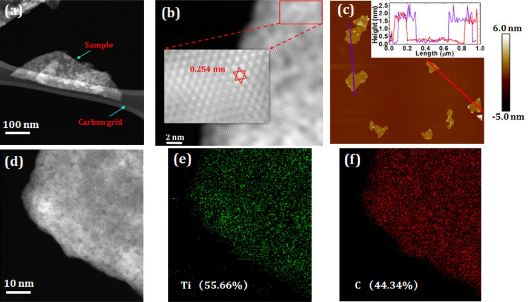
Figure 1 a, b) Transmission electron microscope and high resolution transmission electron microscope images of Ti3C2Tx MXene. c) AFM images of Ti3C2Tx MXene nanosheets with a thickness of less than 2.5 nm were prepared. d-f) Scanning electron microscopy images and related Ti3C2Tx MXene energy dispersive X-ray spectral element diagrams further confirm the presence of Ti and C.
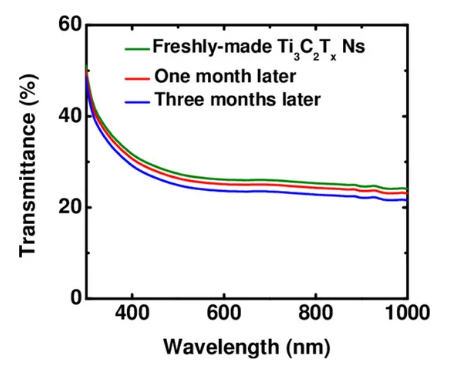
Figure 2 Transmittance of Ti3C2Tx MXene nanosheet dispersions when freshly prepared and stored for 1 month and 3 months.
The morphology and height of Ti3C2Tx MXene nanosheets were characterized by atomic force microscope. The crystal characteristics of Ti3C2Tx nanosheets were characterized by transmission electron microscope and high resolution transmission electron microscope. Finally, an ultraviolet-visible absorption spectrometer was used to detect the transmittance of the Ti3C2Tx MXene nanoplatelet dispersion in the range of 300 to 1000 nm. In addition, three types of laser sources are used in the optical control system: 671 nm, 532 nm and 457 nm continuous wave lasers.
02
experimental device
In the experiment, the nonlinear optical experiment system is shown in Figure 3a. Three lasers with wavelengths of 457, 532 and 671 nm (continuous wave) are used as light sources. First, a 10 mm thick quartz reaction cup is used to load the prepared Ti3C2Tx MXene nanosheets as an information converter. After the laser interacts with the MXene sample, a spatial self-phase modulation effect is generated, forming a diffraction ring. Between the light source and the sample, a lens with a focal length of 20 mm is used to focus the laser beam. When the blue laser beam is dispersed through the MXene nanosheet, the diffraction ring first expands to the ring at 0.84 s (Figure 3b②). Subsequently, due to the non-axisymmetric thermal convection of the Ti3C2Tx MXene nanosheets caused by laser heating, the pattern of the circular diffraction ring continuously and rapidly deformed at 1.84 s (Figure 3b③), forming a semicircular diffraction ring. The patterns in Figure 3b④-⑥ and Figure 3b⑦-⑨ show the changes of the spatial self-phase modulation effect at 532 nm and 671 nm wavelengths, respectively. The expansion and distortion of the diffraction ring can also be observed at these two wavelengths.
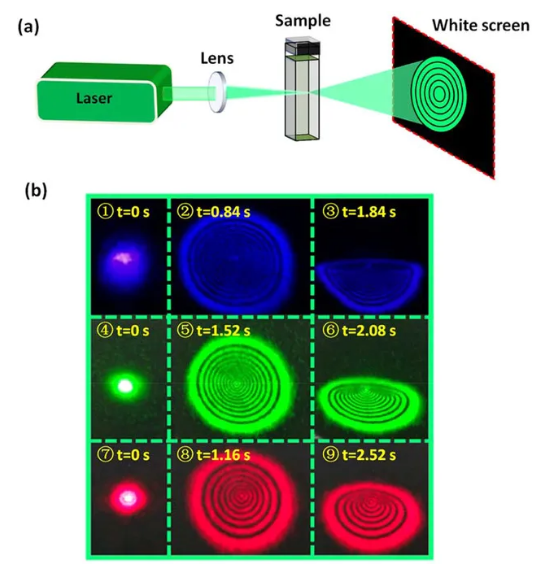
Figure 3 a) Schematic diagram of experimental setup. b) Changes in spatial self-phase modulation. ①-③, ④-⑥ and ⑦-⑨ show the diffraction rings received by the white screen of Ti3C2Tx MXene nanosheets at 457, 532 and 457 nm, respectively.
03
N2 and χ(3) of Ti3C2Tx MXene
The refractive index of Ti3C2Tx MXene nanosheets can be defined as n=n0+n2I, where n0 (n0=1.42) is the linear refractive index, which is approximately equal to the refractive index of isopropanol, and n2 is the nonlinear refractive index of Ti3C2Tx MXene nanosheets , I is the intensity of incident light. Here, the definition of n2 is as follows:
n2=λN/(2n0·Leff·I)
In the formula, λ, N and Leff are the wavelength of the incident continuous laser beam, the number of halos and the effective optical thickness of the solution, respectively. The estimated value of χ(3) is
χ(3)total=cλn0·dN/2.4×104π2Leff·dI
Figures 4a-c show the increase in the number of loops obtained by CCD with increasing intensity at 457, 532, and 671 nm, respectively. The relationship between the incident intensity and the number of rings is shown in Figure 4d. At 457, 532, and 671 nm, the number of loops and the incident intensity have a linear relationship with the slopes of 0.8485, 0.3269, and 0.1961 cm2 W-1, respectively. The nonlinear refractive indices of Ti3C2Tx MXene nanosheets are 11.011×10−4, 4.725×10−4, and 0.447×10−4 cm2 W−1, respectively. The third-order nonlinear polarizability corresponding to a single layer of MXene is 4.34×10−7 (e.s.u.), 1.68×10−7 (e.s.u.) and 0.15×10−7 (e.s.u.). Previous studies have shown that the transmittance of a single layer of Ti3C2T x MXene is 96.6%, while the experimental Ti3C2T x MXene dispersion has similar transmittance values at 457, 532 and 671 nm (457 nm is 28.87%, 532 nm is 26.83% , 671 nm is 26.15%). According to estimates, Neff at 457 nm is 36, Neff at 532 nm is 38, and Neff at 671 nm is 39. Table 1 shows the nonlinear refractive index of Ti3C2T x MXene nanosheets compared with other two-dimensional materials; Ti3C2T x MXene nanosheets have the largest n2 and the strongest nonlinear optical response.
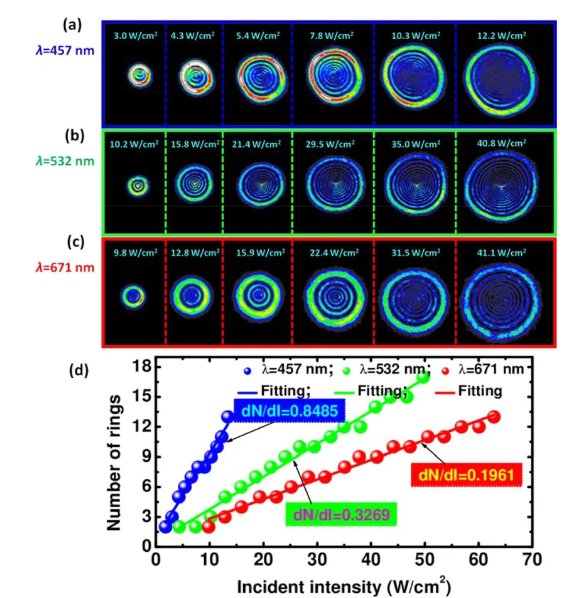
Figure 4 a-c) Diffraction rings received at 457, 532, and 671 nm with increasing incident light intensity. d) The diffraction ring at 457, 532 and 671 nm changes with the incident intensity.
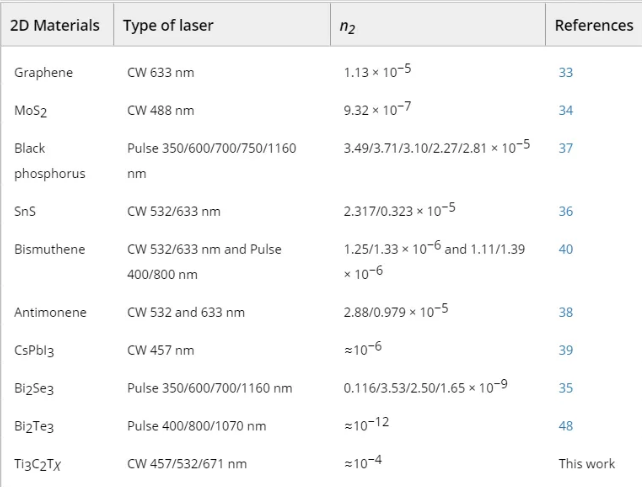
Here, the nonlinear optical properties of two-dimensional materials can be studied in several ways, such as Z-scan, four-wave mixing and spatial self-phase modulation. However, the values obtained often show differences and are largely dependent on characterization techniques and material manufacturing methods. Using the Z-scan method to perform two-photon absorption in a single-layer graphene, the nonlinear refractive index of graphene is calculated to be about 10−7 cm2 W−1, which is larger than the 4.8×10−13 cm2 W−1 obtained by four-wave mixing 6 orders of magnitude. In addition, the refractive index of graphene measured by spatial self-phase modulation is 1.13×10−5 cm2W−1. In this work, the nonlinear refractive index of Ti3C2T x MXene (approximately 10−4 cm2W−1) was calculated using the spatial self-phase modulation method. Compared with the results obtained by Jiang et al. from the Z-scan technique (approximately −10−16 cm 2 W−1), there are significant differences due to different characterization techniques.
04
The influence of distortion on nonlinear refractive index
Due to the non-axisymmetric thermal convection, the laser will produce obvious distortion after being dispersed through the Ti3C2Tx MXene nanoplates. With the enhancement of non-axisymmetric thermal convection, the Ti3C2T x MXene nanosheets in the upper part of the solution will be squeezed to the lower part, resulting in a non-axisymmetric low-density thermal convection. This means that the dispersion in the lower part can produce a stronger nonlinear optical response than the upper part, and excite more diffractive rings. Then, the distortion of the diffractive ring has an important influence on the refractive index of Ti3C2Tx MXene nanosheets. Therefore, the change of nonlinear refractive index caused by distortion is further discussed. Figure 5a shows the image of the diffraction ring before and after distortion. The change in nonlinear refractive index can be calculated as follows:
∆n2/n2=θD/θH=RD/RH
In the formula, RH and RD are the maximum diffraction radius and collapse radius of the diffraction ring, and θH and θD are the half cone angle and collapse angle of the ring pattern, respectively. In Figure 5b, c, R H and RD change with the increase of incident intensity. After fitting and calculation, Figure 5d shows the Ti3C2Tx MXene nanometers caused by the distortion of 457, 532 and 671nm.
The change in the nonlinear refractive index of the rice sheet means that the nonlinear refractive index of the Ti3C2Tx MXene nanosheet will change significantly due to the distortion of the diffraction pattern. The nonlinear refractive index will increase first and then saturate. The relationship between n2 and the total amount of χ(3) can be written as n2=(1.2×104×π2/n20c) χ(3)total=(1.2×104×π2/n20c)·N2effχ(3)monolayer. It can be seen from the equation that n2 has a linear relationship with the effective single layer number N eff. When thermal convection occurs, N eff in the upper half of the laser beam will decrease, resulting in reduced n2. In addition, greater incident light intensity will generate stronger thermal convection, thereby reducing the Neff of the upper half of the laser beam. The density of the MXene nanosheets in the upper half is less than that in the lower half, which causes distortion and becomes more and more obvious as the laser intensity increases. This means that the deformation rate (RD/RH) increases with the increase of the laser intensity, but due to conditions, the distortion rate cannot increase indefinitely: RD
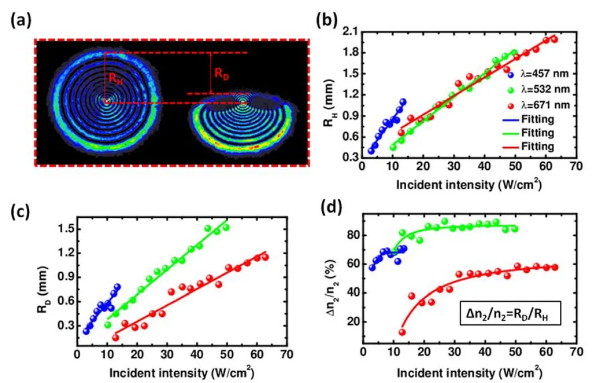
Figure 5 a) Distorted image of the diffraction ring. b, c) As the incident intensity of the laser beam increases, the maximum diffraction radius changes before and after distortion. d) The influence of distortion on the nonlinear refractive index of Ti3C2T x MXene nanosheets.
05
All-optical modulator based on Ti3C2Tx MXene
Using the optical control light system, the spatial cross-phase modulation method is used to conduct experimental research on the all-optical modulator based on MXene nanosheets. In other words, use a relatively strong pump light (671 nm) to modulate/manipulate another relatively weak probe light (532 nm). In the experiment, the Ti3C2T x MXene solution was used as the information converter to realize the modulation of the pump light to the probe light. The change of the pump light intensity will interact with the Ti3C2T x MXene solution, which will cause the probe light to undergo a nonlinear phase transition. As the intensity of the pump light increases, the ring number of the probe light and the size of the diffraction pattern can be controlled. Figure 6a shows the configuration of the optical control system based on the Ti3C2T x MXene nanosheet dispersion using the spatial cross-phase modulation method. The 671 nm laser beam is used as the pump light and is coupled with the probe light (532 nm) through a beam splitter. When the combined dual-wavelength beam passes through the lens and Ti3C2T x MXene nanosheets, the diffraction ring pattern can be observed on the screen.
The measurement results of the all-optical modulator based on Ti3C2T x MXene nanosheets are shown in Figure 6b. First, adjust the intensity of the green 532 nm probe light to a relatively low value (1.14 W cm−2), which is lower than the threshold and cannot excite the diffraction ring (the green laser spot in Figure 6b①). After that, another more intense 671 nm pump light (red dot in Figure 6b②) was used to interact with the Ti3C2T x MXene nanosheet to excite the nonlinear optical properties of the sample, and then obtain the diffraction pattern to occur, and at the same time, induce detection The diffraction ring of the needle light (Figure 6b③) collapses rapidly (Figure 6b④). When the incident intensity of the pump light is modulated to 5 W cm−2 and the probe light remains at 1.14 W cm−2, the ring number of the probe light is 1. After that, as the intensity of the 671 nm probe light increases, the number of rings of the probe light and pump light also increases (Figure 6b③).
Figure 6 a) All-optical modulator based on dual-wavelength laser beam (532 nm and 671 nm). b) The image of the change process of the diffraction ring: ①The probe light with a weak intensity below the threshold passes through the sample, at this time, ②Another strong pump light couples with the probe light and interacts with the sample, ③Pump light The diffraction ring of the probe light and the probe light have been formed in the Ti3C2Tx MXene information converter. The result obtained by modulating the probe light (532 nm) with the pump light (671 nm) (d) Contrary to this, the 532 nm laser can also be used as The pump light modulates the 671 nm laser (as the probe light), and ① and ② show the changing process of the diffraction ring.
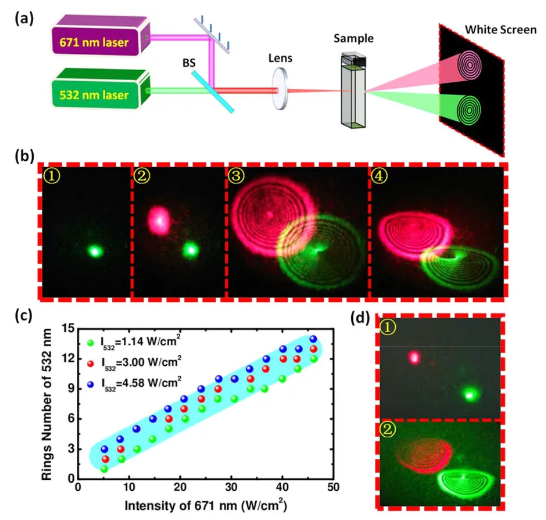
Figure 6c illustrates the modulation relationship between the pump light and the probe light. It can be seen that the pump light can be used to modulate the increase in the number of probe rings. The relationship between them increases linearly, indicating that the nonlinear phase of the probe light has changed significantly due to the increase in the intensity of the pump light. Conversely, a 532 nm laser can also be used as a pump light to control a 671 nm laser (as a probe light). As shown in Figure 6d, relatively weak light (probe light) can be modulated by stronger light (pump light). This shows that it has good application prospects in nonlinear phase modulation. Therefore, the strong nonlinear optical response of MXene nanosheets can be used to create an all-optical modulation device with two wavelengths of light. In addition, MXene-based all-optical modulators can also be designed with single-wavelength light (671 nm). The system of single wavelength light (671 nm) based on MXene all-optical modulator is shown in Figure 7a. When single-wavelength light passes through the beam splitter, it will be split into two beams. Using the optical attenuator, two lasers with strong power and weak power can be obtained respectively. Using weak light as the probe light and strong light as the pump light, a single-wavelength all-optical modulator based on Ti3C2Tx MXene can also be designed, as shown in Figure 7.
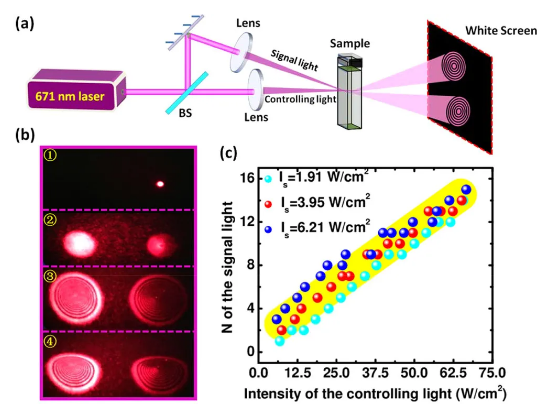
Figure 7 a) All-optical modulator based on a single beam (671 nm). b) The image of the change of the diffraction ring; c) By controlling the intensity of the pump light (671 nm), the number of rings of the detection light (671 nm) is modulated with a lower power.
06
All-optical switch based on Ti3C2Tx MXene
When the pump light intersecting the probe light (Figure 8a) is introduced into the MXene solution, the phase of the probe light is modulated to produce a diffraction ring (Figure 8b) due to the nonlinear Kerr effect (Figure 8b). This means that interference signals can be obtained from the probe light by modulating the power of the pump light. When the incident power of 671 nm light (pump light) is adjusted to 52, 60, and 70 mW, the number of rings of the detection light is 4, 5, and 6, respectively. Here, when N=4, a power meter is set on the outermost ring (bright stripes) of the detection light diffraction ring, and at the same time, the power read from the power meter is 17.5 μW, which increases with the power of the pump light To a larger value (60 mW), the power of the fixed point of the power meter falls on the dark stripe, and the minimum power (1.3 μW) is obtained. When the incident power of the pump light continues to increase to 70 mW, the power at this point increases to bright The fringe has a maximum power of 17 μW. As shown in Figure 8c, the power of the probe light at a fixed point increases and decreases periodically with the increase of the pump light power. This phenomenon realizes the phase change modulation of the probe light by controlling the power of the pump light, and has a good application prospect in all-optical switches.
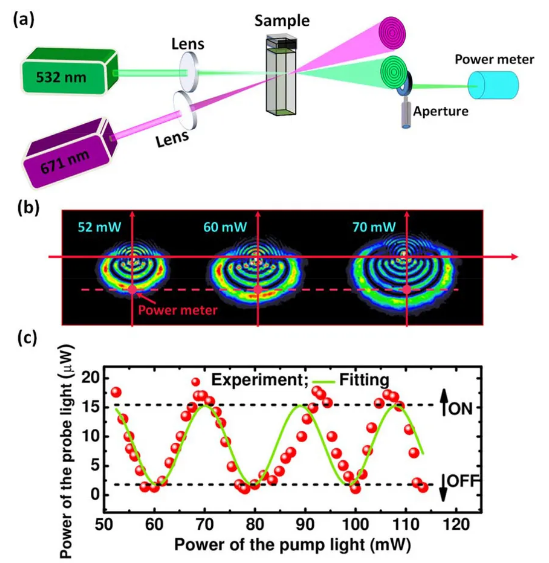
Figure 8 a) All-optical switch based on Ti3C2Tx MXene nanosheets. b) The change of the probe light diffraction ring when the pump light power changes from 52 to 70 mW. c) In the all-optical switch, the probe light modulated by the pump light realizes two modes of "on" and "off".
07
Light/Ti3C2Tx MXene interaction mechanism
The optical band gap of Ti3C2Tx MXene nanosheets is as narrow as 0.1 eV, which means that the laser wavelengths of 457 nm (2.71 eV), 532 nm (2.33 eV) and 671 nm (1.85 eV) can be used as light sources for interaction with Ti3C2T x nanosheets . Due to the Kerr effect, the reflection index of Ti3C2T x nanosheets varies with the incident light intensity. When Gaussian light passes through the Ti3C2T x nanosheet, the phase shift (∆ψ) of the light is as follows:
∆ψ=(2πn0/λ)∫0Leffn2I(r,z)dz
Among them, r and I (r, z) respectively represent the radial position and intensity distribution of the incident light. In the range of r∈[0, +∞), there are two points r1 and r2 that satisfy the equation (d∆ψ/dr) r=r1=(d∆ψ/dr)r=r2, as shown in Figure 9. The slopes of these two points are the same, which means they have the same wave vector to cause interference. The light and dark stripes are determined by the following formula:
∆ψ(r1)-∆ψ(r2)=Mπ (M is an integer)

Figure 9 The optical bandgap structure of Ti3C2T x MXene nanosheets excited by a wide spectrum of free carriers and the mechanism of light interaction with Ti3C2T x MXene nanosheets.
When M is an odd number, dark stripes appear, and when M is an even number, bright stripes appear. This is a phenomenon of spatial self-phase modulation, and the number of rings (N) can be obtained from [∆ψ(0)-∆ψ(∞)]=2Nπ. In spatial cross-phase modulation, the nonlinear refractive index of Ti3C2Tx MXene nanosheets is first affected by the pump light, and then the probe light induces the nonlinear phase change. The effect of the nonlinear optical response of Ti3C2Tx MXene nanosheets can be explained as the repositioning and alignment of MXene nanosheets caused by electromagnetic fields.
08
Outlook
Here, the strong nonlinear optical response of high-quality Ti3C2T x MXene nanosheets was measured by the spatial self-phase modulation method. A large nonlinear refractive index (n2≈10−4) is several orders of magnitude higher than other two-dimensional materials (such as graphene, MoS2, Bi2Se3), which indicates that MXene materials have good application prospects in nonlinear photonic devices. Compared with other two-dimensional materials, MXene material has stronger nonlinear optical response, higher stability and narrower band gap. Therefore, MXene is expected to become a new type of nonlinear photonic material. Taking advantage of the high optical nonlinearity of Ti3C2Tx MXene nanosheets, a new type of optical control system based on spatial cross-phase modulation of all-optical modulators and switches is designed. Studies have shown that the pump light can be used to modulate the nonlinear phase of the probe light, which has certain application prospects in all-optical modulators. In order to further study the proposed optical control optical system with Ti3C2Tx MXene nanosheets, another all-optical switch is proposed. In the switching device, due to the spatial cross-phase modulation effect, the diffraction pattern of the probe light can be modulated by the pump light to achieve two modes of "on" and "off". Therefore, it is predicted that two-dimensional MXene may have potential applications in all-optical switches, modulators and other advanced photonics devices in the foreseeable future.
Source: Optical Frontier Review
This information is from the Internet for academic exchanges. If there is any infringement, please contact us and delete it immediately

| Reminder: Beijing Beike New Material Technology Co., Ltd. supplies products only for scientific research, not for humans |
| All rights reserved © 2019 beijing beike new material Technology Co., Ltd 京ICP备16054715-2号 |